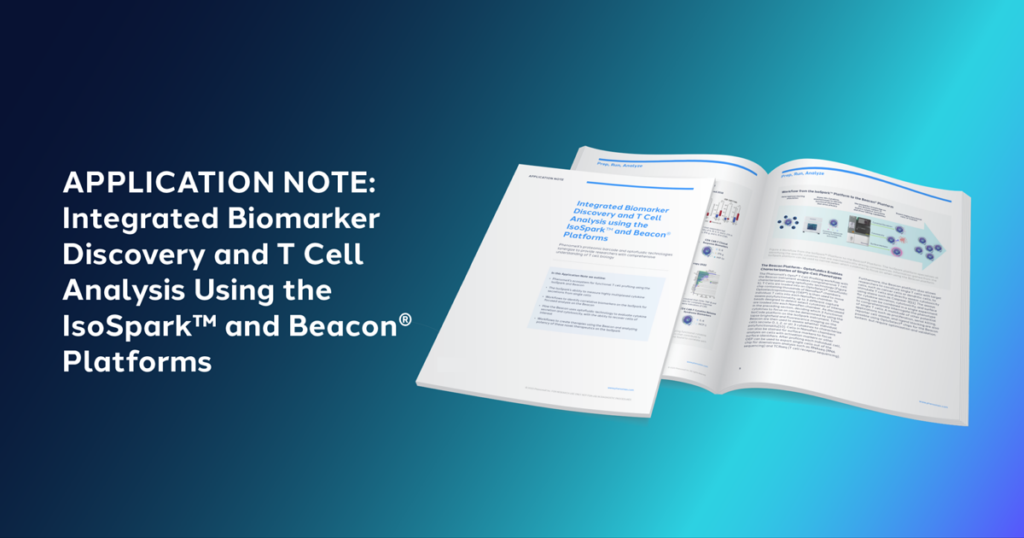The key to developing successful immunotherapy treatments lies in harnessing the power of our immune system, specifically by profiling individual T cell function. With advancements in areas like cancer immunotherapy, vaccine development, infectious disease, autoimmune disease, and organ transplantation, there is a pressing need for new biomarkers that can identify and characterize the most potent T cells. However, today’s technologies only provide a limited view of T cell biology, preventing researchers from leveraging the full potential of the phenome.
At Bruker Cellular Analysis, we’ve revolutionized the study of T cell biology with our cutting-edge combination of proteomic barcode and optofluidic technologies. Our integrated suite of tools, featuring the IsoSparkTM and Beacon® platforms, empowers researchers with the ability to gain a comprehensive understanding of T cell behavior. In our latest application note, we unveil the power of these solutions by showcasing how they identify the functional drivers of T cell potency.
Continue reading to learn more about these solutions and how they can enable deeper insights into your research.
IsoSparkTM Platform Enables Highly Multiplexed Single-Cell Proteomics for Biomarker Discovery
The IsoSparkTM Platform enables extensive multiplexed single-cell proteomics, making it a powerful tool for biomarker discovery. The IsoCode® Adaptive Immune chip, designed for the IsoSpark system, supports highly multiplexed analysis of functionally secreted cytokines from individual cells. This unique ability to measure 32 different cytokines secreted from a single cell allows researchers to pinpoint polyfunctional cells, which are specialized cells that can secrete multiple cytokines. They play a crucial role in enhancing adoptive cell therapy effectiveness, improving patient responses, and optimizing vaccine efficiency. In addition, the recognition of dysfunctional polyfunctional cells offers valuable insights into potential adverse outcomes in autoimmune diseases, infectious diseases, and transplant rejection.
Revolutionizing Cell Retrieval with Specific Cytokine Profiles
To determine the importance of specific cytokine profiles, a highly multiplexed analysis to screen for impactful biomarkers is critical. Bruker Cellular Analysis’ IsoCode® platform enables scientists to uncover cytokine biomarkers in preclinical and clinical settings. However, identifying polyfunctional cells and cytokine secretions that correlate with biological outcomes is just the first step toward a more complete understanding of the cell phenotypes.
For researchers who want to retrieve cells with specific cytokine profiles, Bruker Cellular Analysis’ Beacon® platform is invaluable. Utilizing cutting-edge optofluidic technology, the Beacon platform can detect select cytokine secretions form single cells, measure polyfunctionality, characterize cytotoxicity, and identify surface markers to identify cellular subsets. Cells exhibiting desirable characteristics can then be retrieved for analysis.
Characterizing Single-Cell Phenotypes: The Power of Optofluidic Technology
Comprehensive T cell characterization using optofluidic technology is now possible with Bruker Cellular Analysis’ Opto® T Cell profiling workflow using the Beacon® optofluidic system. T cells are loaded into an OptoSelect® nanofluidic chip containing thousands of NanoPen® chambers. Optoelectropositioning (OEP®) technology is then used to move individual T cells into each chamber. To assess polyfunctionality, up to three different capture beads are loaded into each chamber. Time lapsed brightfield and fluorescence imaging module on the Beacon system are then used to assess whether individual cells secrete 0, 1, 2 or all 3 cytokines to characterize polyfunctionality. The cells in the chambers can also be stained for surface markers. Once the individual cells have been profiled, OEP can export single cells from the chip for downstream analysis. In addition, the assays for cytokine secretion, cytotoxicity, and surface staining can be combined in a single experiment, allowing researchers to interrogate the phenotype of a single T cell.
Bridging Single-Cell Proteomic Polyfunctionality with Transcriptomics, Immunogenomics and More
The Beacon® optofluidic system’s cell export capabilities pave the way for diverse downstream analysis pathways, offering deeper insights. This allows the linking of phenotypes measured on the Beason system with gene expression of immunogenomics to explore the underlying drivers of functional proteomics. For example, in a recent study, T cells were obtained from a patient who was previously treated with a cancer vaccine. The Beacon system isolated individual T cells into NanoPen ®chambers and cocultured them with peptide pulsed dendrite cells to identify functional T cells. After assaying thousands of individual T cells, those with polyfunctional cytokine secretions were identified and characterized using downstream TCR sequencing.
Connecting the Dots to Characterize the Entire Phenome
By using workflows that leverage the strength of both the IsoSparkTM platform and the Beacon® platform, researchers can effectively connect multiplexed discovery, functional analysis and downstream retrieval of cells of interest. The IsoSpark platform empowers researchers to discover polyfunctional biomarkers and cytokine drivers of biological function, while the Beacon platform provides a multitude of ways to assess T cell functionality and analysis specific phenotypes of interest. Bruker Cellular Analysis’ unique, patented proteomic barcode and optofluidic technologies offers the potential to reveal impactful insights that are otherwise inaccessible when using traditional technologies.
To take a deeper look with figures and case studies, download our app note, Integrated Biomarker Discovery and T Cell Analysis using the IsoSparkTM and Beacon® Platforms.


